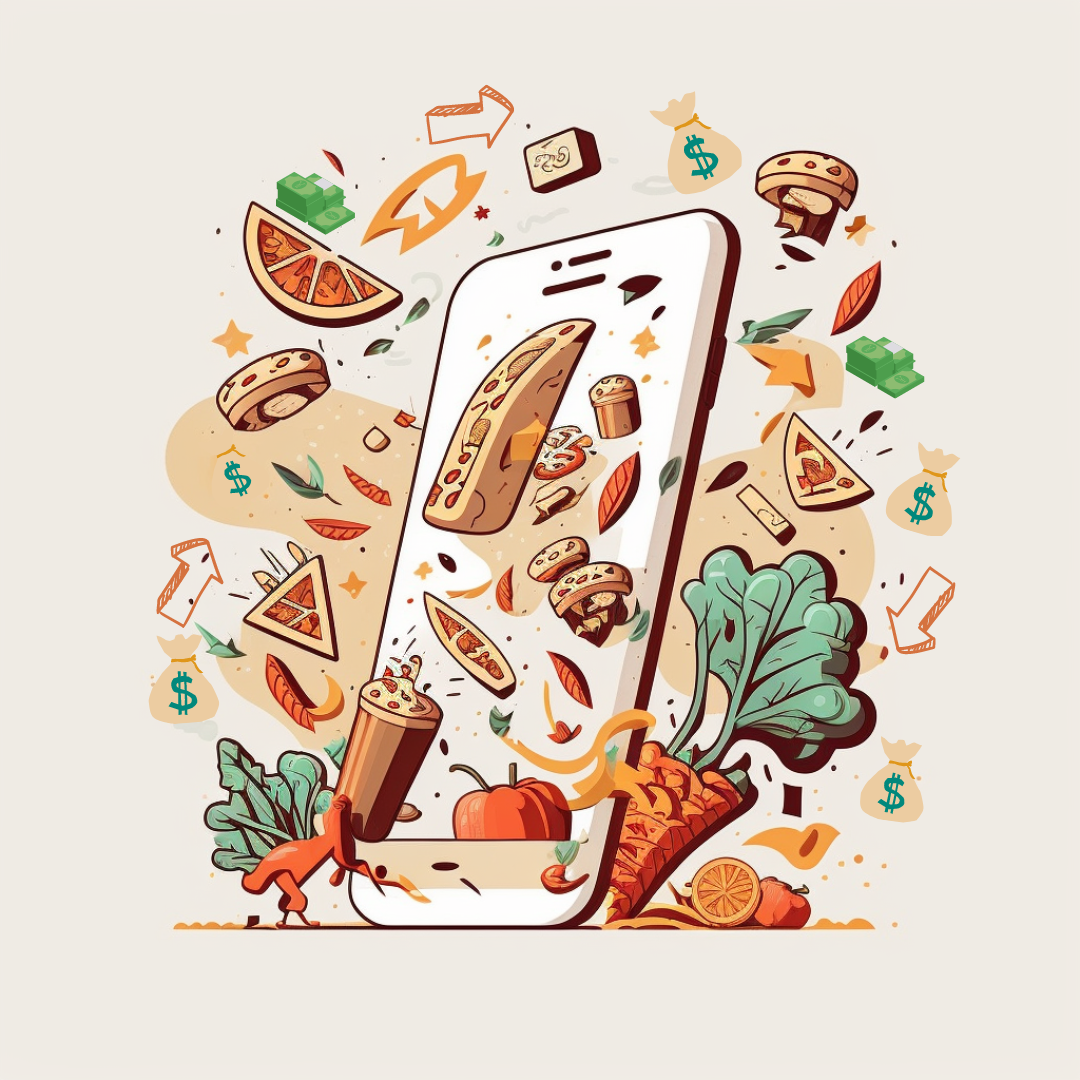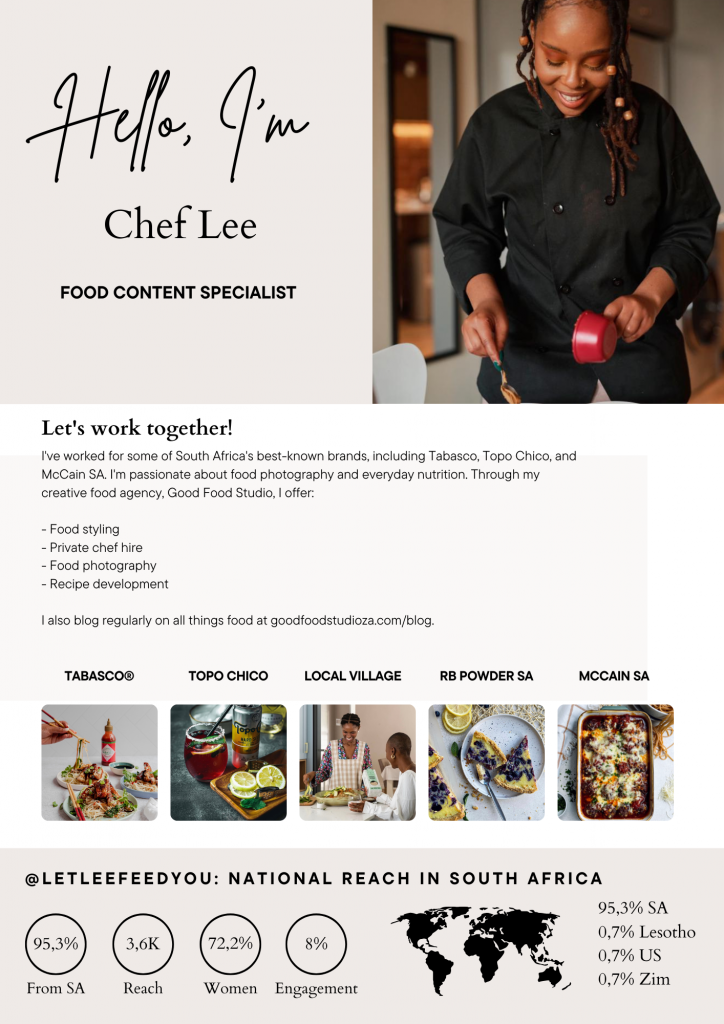Raise your hand if you’ve ever been called delusional for thinking that creating food content on social media is a real job?
I know I have – in fact, I think most people who’ve pursued a career in social media have faced some version of this criticism.
The food industry is more than just a means of making a living. It’s a passion for creating, sharing experiences, and passing it forward to continue the cycle of growth in our community.
I want to share the methods and insights I’ve gained to help you monetize your food content.
It all boils down to UPMA:
- Upsize
- Productize
- Monetize
- Advertise
The UPMA framework provides a clear guide for monetizing your food content, which is incredibly helpful when navigating content creation.
This framework can help you create a steady income stream and build a loyal following.

#1 Upsize Your Brand on Social Media
Building a loyal and engaged audience is vital to monetizing food content. Identifying your niche and target audience helps you create content that speaks directly to your ideal followers and brands.
Start by asking yourself the following questions:
- What sets me apart from other creators in my field
- What specific topics do I want to be known for?
- Who do I want to reach with my content?
Once you’ve answered these questions, you can tailor your content to meet your audience’s needs.
There are three steps to leveraging social media for your brand:
- Create a consistent and cohesive look
- Craft a strong bio and profile
- Create a food portfolio PDF
A. Create a consistent and cohesive look
Brands notice a strong and consistent image.
My biggest struggle has been balancing what I want to share against what my audience wants to see.
My followers love when I share candid behind-the-scenes moments and relatable stories.
Use these tips to create a coherent look and feel for your food content:
- Develop a style guide for consistency: This includes a color palette, typography, image styles, and messaging.
- Use consistent lighting: Natural light is best, but invest in a set of lights if you shoot indoors
- Vary your shot angles: Mix up your angles to add visual interest to your feed. Provide variation with close-ups, overheads, and angled shots.
- Stick to a theme: For example, if you’re a vegan food blogger, focus on sharing plant-based recipes and content that aligns with this theme.

B. Craft a strong bio and profile
Your social media bio and profile make a lasting impression.
Your bio communicates your purpose, values, skills, and unique selling proposition (USP), explaining why people should follow or work with you. Think of it as a concise and persuasive pitch.
The “Three Whys” framework helps create a compelling social media bio. Here’s how to use it:
- Why are you creating food content? Use this as the foundation of your bio, and communicate your purpose and values. For example, “I’m passionate about creating healthy, delicious recipes that inspire others to live their best lives.”
- Why is your food content important? Highlight your skills, expertise, or special food knowledge. For example, “With over ten years of experience in the culinary industry, I create flavorful, nutritious meals that everyone will love.”
- Why should people follow you? Highlight the benefits of following your food content, such as inspiration, education, or entertainment. For example, “Follow me for daily recipe ideas, healthy living tips, and mouth-watering food photography.”
C. Create a food portfolio PDF to send to brands
Your food portfolio should show off your best creations in a clear and organized way. It’s an opportunity to demonstrate your range and creativity as a food content creator.
Here are some steps you can take to build a strong food portfolio:
- Define your brand: Indicate your niche, values, and target audienc.
- Curate your content: Select your best food content and ensure it aligns with your brand. Include high-quality images and videos.
- Organize your content: Create categories for your content, such as recipes, food photography, and videos. This makes it easier for brands to navigate and find the content they want to see.
- Show versatility: Include different food-related content in your portfolio to showcase your skills and expertise. For example, if you specialize in healthy cooking, include recipes for different diets and cuisines
- Include your stats: Show your engagement rates, follower count, and other metrics that demonstrate social media success
- Highlight your collaborations: If you’ve worked with food brands, include examples of collaborations and how you helped your clients achieve their goals.
- Keep it updated: Your portfolio is a living document, so keep it updated with your latest and best work.
I used Canva to create my portfolio, but you can also use InDesign to craft one.

#2 Productize your food content
As you build your audience, think about how you’ll monetize it.
Here are some ways to productize your food content to attract brands:
- Sponsored content: Work with brands to create sponsored posts, recipes, and other content that promotes their products or services.
- Affiliate marketing: Include affiliate links in your content to earn a commission when your followers purchase through your link.
- Selling your products or services: Compile your recipes and food content into an e-book or cookbook that brands can purchase or offer as a customer freebie. This allows brands to tap into your expertise and credibility in the food industry. Other examples are meal plans, cooking classes, or food styling services.
- Display advertising: Place ads on your social media pages and earn revenue based on clicks or impressions.
The best way to create high-demand products is to know your audience and what they like.
Here are some ways to gather information about your audience’s needs:
- Social media listening: Monitor social media platforms and engage with your followers to understand what they seek.
- Surveys: Create and distribute surveys to your audience to get feedback on their needs and preferences.
- Keyword research: Use tools like Google Trends and Google Keyword Planner to identify popular food-related search terms.
- Competitor analysis: Study competing content and identify gaps you can fill.
With a good understanding of your audience’s needs, you can tailor your content to meet those needs.
#3 Monetize Your Work
There is no one-size-fits-all approach to pricing your food content.
The best pricing strategy depends on your experience, the project’s scope, the brand’s budget, and your value.
Pricing your work is a content creator’s biggest challenge. I’ve experienced this struggle, worrying that I’m undercharging or that a brand won’t choose me because I’m charging too much.
But as with any other business, pricing is a crucial aspect of your brand.
Charge enough to cover your costs, time, and effort while being competitive and attractive to future clients.
Let’s say a food brand is interested in hiring you to take food photos and style their social media accounts.
They want five high-quality photographs featuring their product and are giving you complete creative control over the final images.
Here’s a possible cost breakdown:
- Time: Consider the time and expertise required to complete the job. This includes brainstorming, prop shopping, food prep, shot styling, shooting, and editing the images. Depending on your experience level, you may charge anywhere from R1 000 to R3 500 per hour.
- Props: You’ll need to source props and materials for the shoot, such as plates, utensils, napkins, and backdrops. You’ll need to purchase or rent these items if you don’t own them. A basic set of props could cost anywhere from R900 to R2 000, while more specialized props could run up to R9 000 or more. I typically shop for antique props from thrift stores such as Hospice, but you can also check out Mr. Price Home, FOOD Photography Prop Shop, and Creative Barn.
- Ingredients: The brand may provide the product, but you may need to purchase other ingredients for the shoot, such as fresh produce and herbs. The cost will depend on the recipe and the ingredient quality but could range from R350 to R2000. Depending on the job scope, I might shop at local grocery stores like Woolworths or Checkers. You can also check out your local markets for fresh produce.
- Travel: If the shoot takes place off-site, factor in the cost of travel and transportation. This could include gas or public transportation fares, parking fees, or a rental car. This cost varies widely depending on the location and distance of the shoot.
- Equipment: You’ll need a camera and possibly other equipment, such as lenses or lighting. You’ll need to purchase or rent these items and may spend anywhere from R9 000 to R35 000. You can rent camera equipment from Cameraland, CAM-A-LOT, or A Lens for Hire.
Based on this breakdown, the project’s total cost could range from R18 000 to R55 000.
Communicate these costs clearly to the brand. Ensure your rates are fair and reflect the value of your time and expertise.
Read Mo’s guide to content creator pricing for more tips.

#4 Advertise your content
Work on your accounts to keep your audience interested, as neglecting your social media presence hurts your growth. Let’s discuss four practical ways to promote your offerings and grow your audience:
- Use social media features
- Collaborate with other creators
- Leverage social media ads
- Send cold emails or DMs
1. Use social media features to boost engagement
Social media platforms have features that can boost your engagement and reach more people. A few of these features include:
- Instagram Reels: Reels are short, 15-second videos on Instagram. They are a great way to showcase your creativity and reach new people.
- Instagram Stories: Stories are temporary posts (lasting up to 24 hours) that keep your audience engaged. You can use polls, quizzes, and other interactive features in your Stories to encourage engagement.
- Facebook Groups: These communities are great for building a following around your content. You can create a group for your followers to share their recipes, ask for advice, and interact with other community members.
2. Collaborate with other creators
Collaborating with other content creators and food influencers is a great way to reach new audiences. Here are a few tips:
- Find creators with a similar audience and create complementary content. Reach out to them and pitch a collaboration idea.
- Guest-post on other creators’ blogs or social media accounts to reach new audiences and establish expertise.
- Promote each other’s content to drive traffic and bookings.

3. Run social media ads
Social media ads let you target specific demographics and interests.
For example, if you’re a vegan blogger in a major city, you can target people in that city who are interested in veganism, healthy eating, and sustainable living.
Ads also offer flexibility. You can create eye-catching and engaging photos, videos, and carousel ads.
Ads cost money, but the return on investment can be worth it. You can raise brand awareness and get people to visit your website or social media pages, which could lead to new clients.
4. Send cold emails and DMs
Cold emails and DMs can prove highly effective in promoting your food content. Reach out to prospects who may be interested in your offerings to build valuable connections and grow your audience.
Here are some tips for using cold emails and DMs to promote your food content:
- Target the right audience: Before sending cold emails and DMs, research your target audience to ensure you’re reaching out to people likely to enjoy your content or offers.
- Craft a compelling message: Your message should be short and compelling. Start with a friendly greeting, then explain why you’re reaching out and what you have to offer. People are bombarded with messages daily, so make sure your message stands out.
- Follow up: Don’t be discouraged if they don’t respond immediately. Follow up with a friendly reminder a few days after your initial message.
- Provide value: Offer a special discount, exclusive content, or share helpful information about your niche.
- Be genuine: People can tell when they’re receiving a generic, impersonal message, so personalize each message to show you’ve done your research.
Here’s an example of a cold email our managing editor sent to a magazine to propose monthly contributions:
Subject: Editorial Inquiry | [Magazine name] x Good Food Studio
Hi [Name of person in charge of food content],
I’m the managing editor of Good Food Studio, a creative food agency in SA.
We’d love to find out what topics and themes you’ve planned for the next edition of [Magazine] that we could contribute to.
Good Food Studio has published extensively about the business and craft of food (like corporate catering, recipe development, and food styling).
We’ve worked with top brands like Sasol, PwC, and Ernst & Young, and we regularly host themed cooking classes (such as plant-based, meat-based, and grain-based).
Please let me know if you accept guest contributions, what topics are on your radar, and what your editorial process looks like.
Thank you,
Mo Shehu
Managing Editor
goodfoodstudioza.com
P.S. You can view some of our work at goodfoodstudioza.com/blog.
The email was concise, impactful, and effective.

Build a foundation for your food content
My food content is a series of building blocks. Like building a house, each block must be stacked carefully and reinforced to create a sturdy structure.
In the same way, my content needs to be consistently good, with each piece building on the previous one to create a strong and cohesive brand.
It’s a constant process of building, refining, and improving, but when all the pieces come together, the result is a beautiful and impactful representation of my brand.
If you’re thinking of elevating your brand’s image and attracting more customers, ask yourself the following questions:
- Am I creating enough relevant content for my audience?
- Am I using the right style of food photography?
- Am I collaborating with the right influencers?
- Do I have a cohesive food content style?
- Am I promoting my brand enough?
If you answered “no” to any of these questions, it’s time to re-evaluate your food content strategy.
As a skilled food content creator, I can help position your brand through compelling visuals and food writing. Contact me today to discuss your food content creation needs.
In health, happiness, and good business,
Chef Lee
If this issue resonated with you, feel free to share it with someone who’d find it helpful! Special thanks to Dr. Shehu for helping me edit this piece